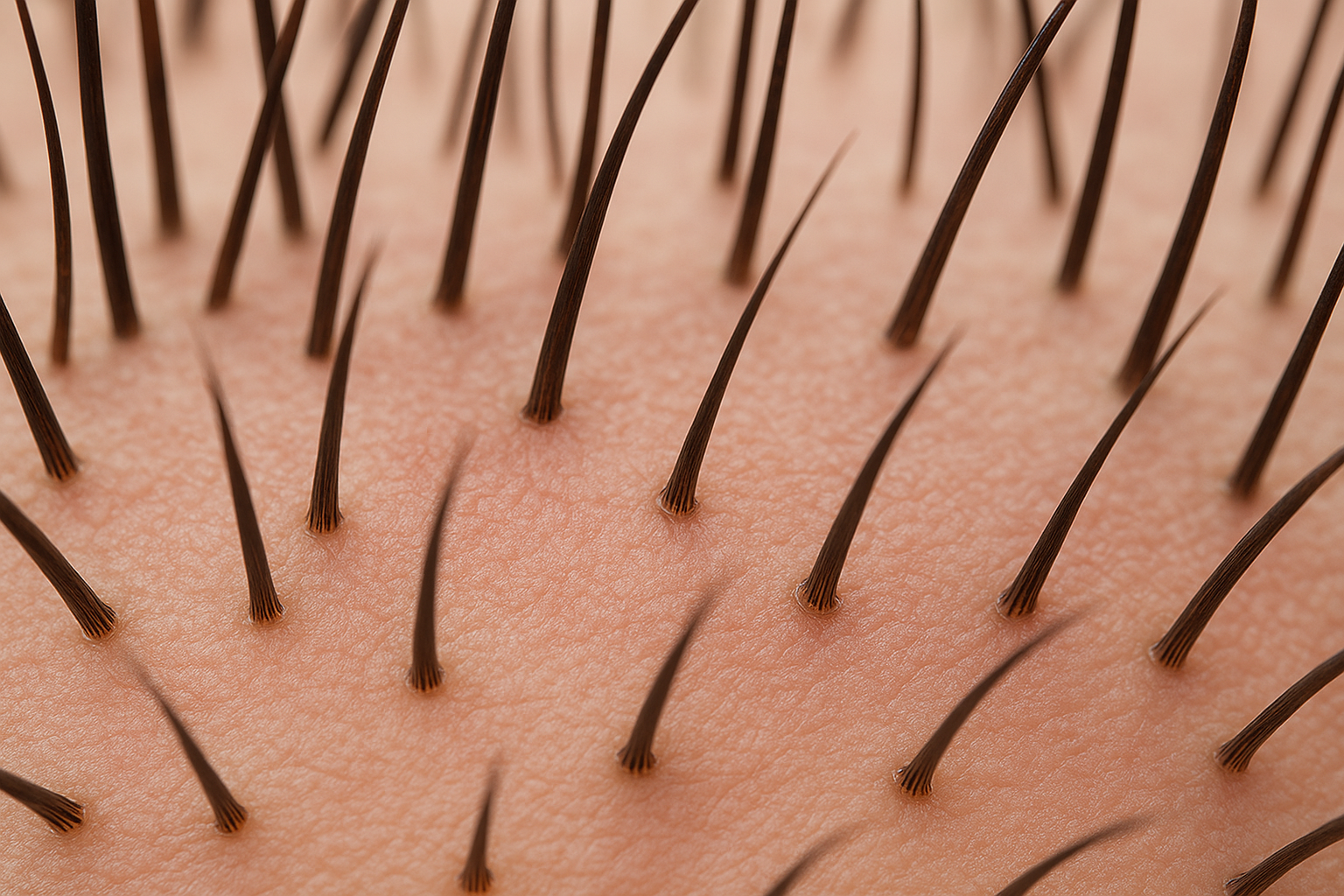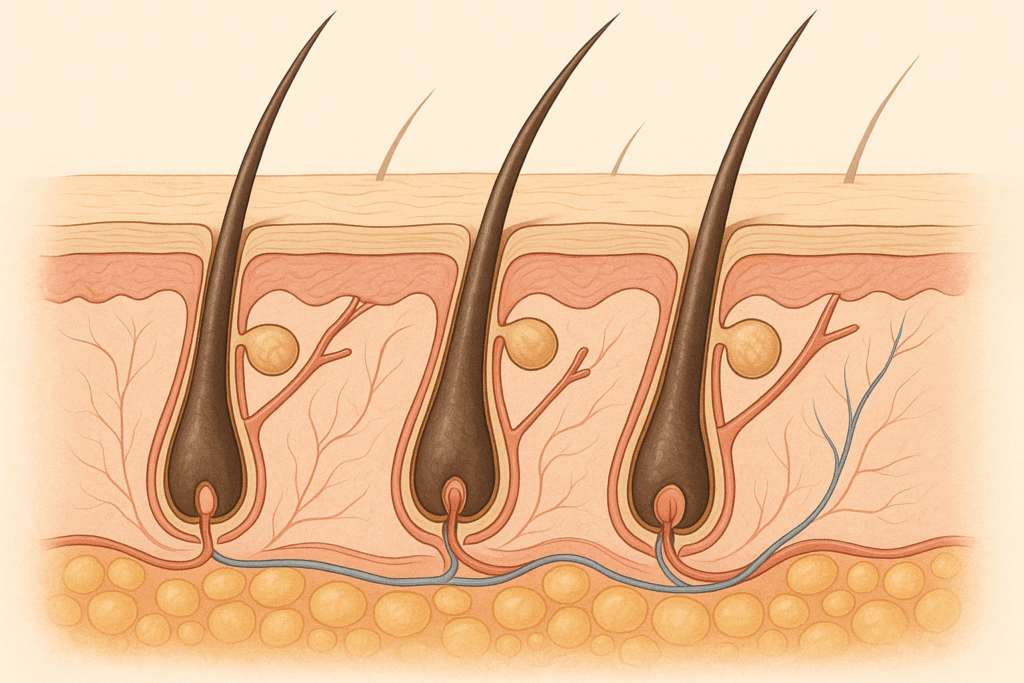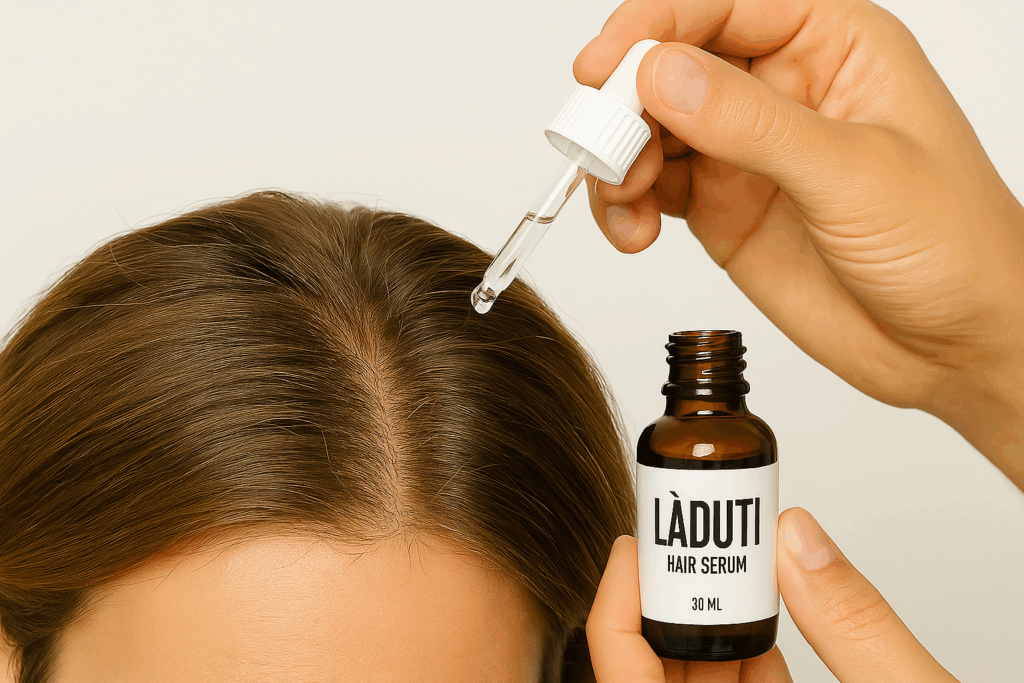Hair follicles: Structure, function and their importance for healthy hair

Hair growth is a fascinating biological process that takes place in secret. Central to this process are the hair follicles - tiny but highly complex structures in the skin. They determine whether our hair grows strong, thick and healthy or whether it thins and falls out.
Here you can find out how hair follicles work, what factors influence them and what you can do to provide them with optimal support.
1. What are hair follicles?
Hair follicle
They are small invaginations in the skin from which each individual hair grows. They surround the hair root and are the actual production site of the hair.
- Each person has around 5 million hair follicles
- Around 100,000-150,000 of these are on the scalp
- The number of follicles is genetically determined - new follicles cannot be formed
Important: Whether hair grows thick, dense or fine depends largely on the activity and health of these follicles.
2. Structure of the hair follicles
Hair bulb (bulb)
Contains the matrix cells that constantly divide and thus allow the hair to grow continuously.
Papilla
Supplies the hair with nutrients and growth factors via fine blood vessels. It is the "supply center" of the hair.
Sebaceous glands
Produce sebum, which keeps the hair supple, protects it from drying out and provides a natural shine.
The arrector pili muscle
A tiny muscle that is responsible for the well-known "goose bumps" - it contracts and straightens the hair through e.g. emotional impulses from the nervous system.

3. How do hair follicles function?
Hair follicles go through continuous growth cycles that determine when hair grows, rests or falls out.
The three phases of the hair cycle
Anagen phase (growth phase)
- Duration: 2-6 years
- Around 85-90% of all hair is in this phase
- During this time, the hair grows actively and increases in length
Catagen phase (transition phase)
- Duration: approx. 2 weeks
- Stops hair growth
- The connection between the hair root and the papilla loosens
Telogen phase (resting phase)
- Duration: 2-4 months
- The hair eventually falls out
- The follicle then starts a new cycle
Conclusion: Each follicle can go through several dozen cycles during its lifetime - which is why hair growth is fundamentally a renewable process.
4. What factors influence hair follicles?
Performance depends on internal and external factors:
Genetics
The predisposition to hereditary hair loss (androgenetic alopecia) is the most important influencing factor. In this case, the follicles are particularly sensitive to certain hormones.
Hormones
The male sex hormone testosterone and its breakdown product dihydrotestosterone (DHT) can shrink hair follicles and thus slow down hair growth.
Nutrients
Zinc, iron, biotin and vitamin D are crucial for healthy hair roots. Even slight deficiencies can lead to hair loss.
Stress & Lifestyle
Constant stress, lack of sleep and nicotine increase the cortisol level and weaken the follicles.
Circulation
Good blood circulation to the scalp ensures an optimal supply of oxygen and nutrients to the hair roots.
5. How can hair follicles be strengthened?
The good news is that they are sensitive, but can also be trained. With the right measures, they can be strengthened in the long term.
Nutrition: nutrient supply from the inside
A balanced diet with sufficient vitamins, minerals and proteins is the basis for healthy follicles.
- Iron for the oxygen supply
- Zinc for cell division
- Biotin for keratin formation
- Proteins as the basic building blocks of hair
Scalp care: massages & circulation
Gentle scalp massages stimulate blood circulation and improve the supply of nutrients. Just 5-10 minutes a day can help the hair follicles to remain more active.
Herbal active ingredients: Natural boosters
- Rosemary oil prolongs the growth phase (anagen phase)
- Caffeine stimulates the follicles directly
- Saw Palmetto inhibits the effect of DHT and thus protects the hair roots
Gentle hair care
- Avoid harsh chemicals such as sulphates or parabens
- Reduce heat styling (straightener, hairdryer, curling iron)
- Use mild shampoos and moisturizing care products
In conclusion: Specifically support hair follicles
Hair follicles are the key to strong hair growth. Their health determines whether hair remains thick, strong and resistant. With a combination of a balanced diet, targeted scalp care, plant-based active ingredients and gentle hair care, the follicles can be sustainably strengthened. A high-quality hair serum directly supports the supply of hair roots and promotes long-term hair growth.
This is precisely where our Laduti Hair Serum comes in: It combines scientifically studied ingredients such as AnaGain™ (from pea sprout extract) and Procapil™ (with Biotinoyl-GHK, Apigenin, and Oleanolic Acid). These active ingredients are known to revitalize hair follicles, support the scalp, and improve the conditions for healthy hair growth – without resorting to aggressive chemicals like Minoxidil.
This allows you to strengthen your hair follicles naturally and create the basis for strong, full hair.

FAQ
Is it possible to form new hair follicles?
No, the number is genetically determined. They cannot be multiplied, but existing follicles can be strengthened and kept active.
Why do follicles atrophy?
Hormonal influences (e.g. DHT), nutrient deficiency or stress can cause follicles to become smaller and produce finer hair.
How long does it take for hair follicles to respond?
Hair cycles are slow - visible changes often require 3-6 months of consistent care.
Can inactive hair follicles be reactivated?
Yes, as long as follicles are not completely scarred, they can be reactivated with suitable care, active ingredients or therapies such as PRP or microneedling.
Which active ingredients can strengthen hair follicles?
Natural ingredients such as caffeine, rosemary extract, ginseng and special complexes such as Procapil™ or AnaGain™ can activate the hair roots and nourish the scalp.

